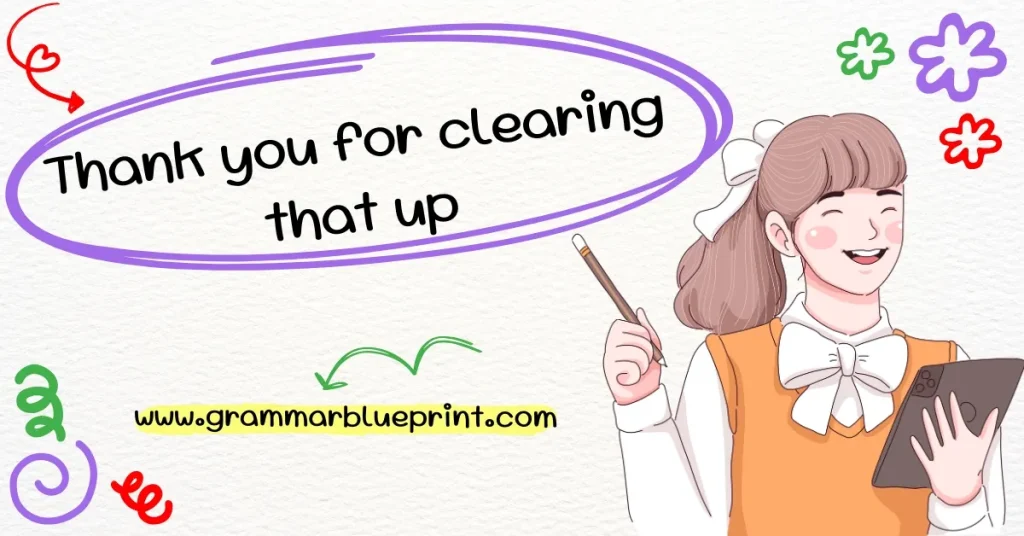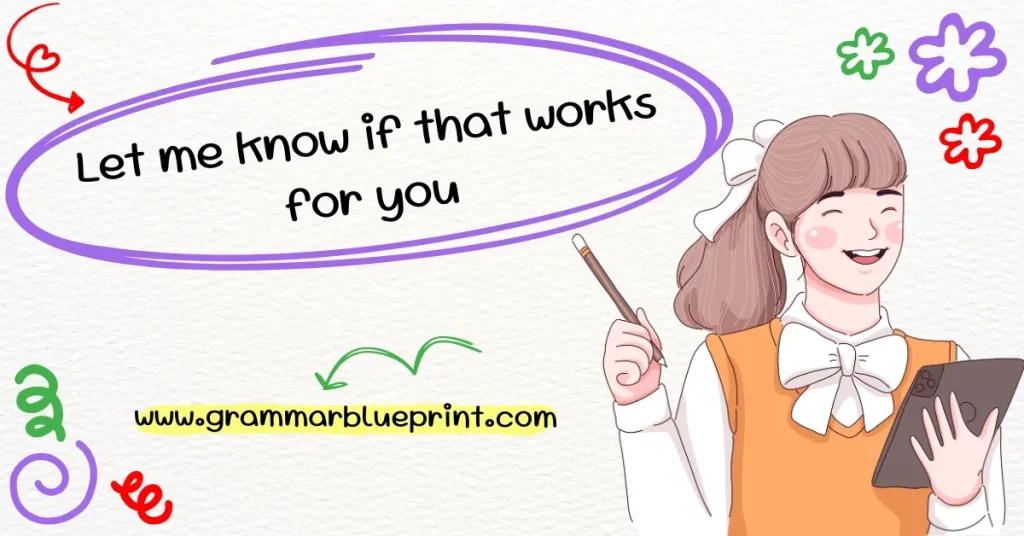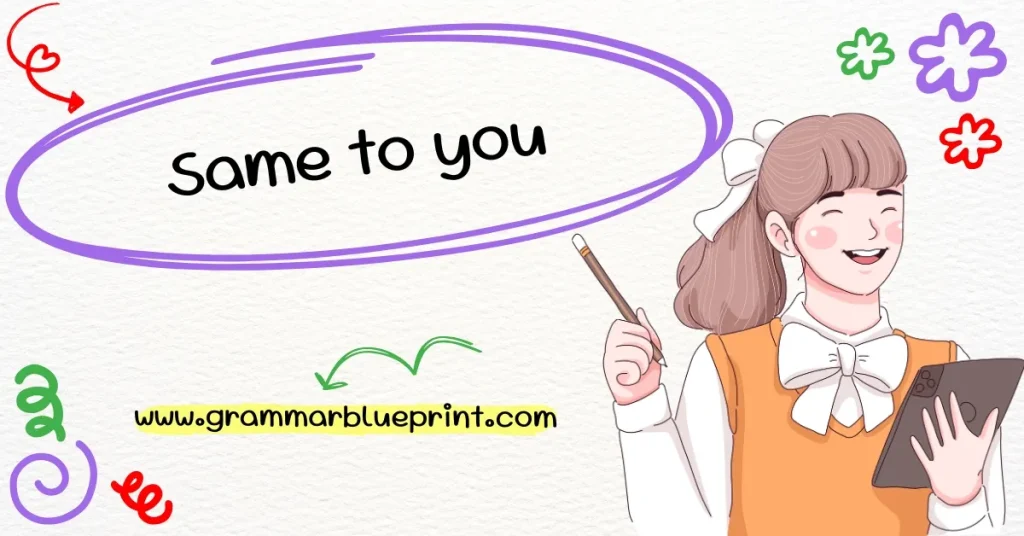In every conversation, whether professional or casual, clarity plays a crucial role in effective communication. One common way people express appreciation for a clearer explanation is by saying, “Thank you for clearing that up.” This simple yet powerful phrase can strengthen relationships, enhance understanding, and facilitate better dialogue. In this article, we will explore the meaning, proper usage, benefits, and alternatives to this phrase, along with tips for responding and understanding cultural differences in gratitude for clarification.
What Does “Thank You for Clearing That Up” Mean?
The phrase “Thank you for clearing that up” is commonly used when someone provides a clear and helpful explanation of something that was previously unclear or confusing. It’s a polite expression of gratitude acknowledging that the speaker now understands a concept better due to the explanation received.
Situations Where This Phrase Is Commonly Used:
This phrase is typically used in conversations or discussions where a clarification or explanation is provided. For example, in business meetings, if a colleague provides a detailed answer to a complex question, you might say, “Thank you for clearing that up.” Similarly, in casual conversations, when someone explains something you didn’t understand, you can use this phrase to show appreciation.
When to Use “Thank You for Clearing That Up”
“Thank you for clearing that up” can be used in both formal and informal contexts, making it a versatile phrase. In professional settings, it’s an ideal way to acknowledge a colleague’s effort in providing a clearer perspective on a topic. In casual conversations, it helps convey gratitude when someone explains something you were unsure about.
Common Scenarios Where This Phrase Is Helpful:
- Business and Professional Settings: During meetings or emails when seeking clarity on a project or process.
- Classroom or Study Discussions: When a teacher or fellow student explains a difficult concept.
- Casual Conversations: When friends or family explain things you didn’t fully understand initially.
- Customer Service: When a representative provides clear instructions or information.
Benefits of Using “Thank You for Clearing That Up”
Using the phrase “Thank you for clearing that up” comes with several key benefits that help foster positive communication:
- Clarity in Communication: This phrase helps to make sure that you have fully understood the information provided. It prevents misunderstandings by ensuring that both parties are on the same page.
- Enhances Conversation Flow: Expressing gratitude for clarification makes the conversation smoother, allowing the dialogue to continue without confusion.
- Shows Appreciation and Gratitude: It highlights your recognition of the effort someone has put into explaining something, fostering good relationships and mutual respect.
How to Use “Thank You for Clearing That Up” in Different Contexts
Formal Settings (e.g., Meetings, Professional Emails):
In formal settings, the phrase can be used in a professional tone. For example, after a colleague explains a complicated work procedure or process, you can say, “Thank you for clearing that up; I now have a better understanding of the project steps.”
Informal Settings (e.g., Casual Conversations, Friends):
In informal conversations, the tone can be more relaxed. For instance, after a friend explains a simple question or gives advice, you might say, “Ah, thanks for clearing that up! I totally get it now.”
Written Communication (e.g., Emails, Text Messages):
When responding to written clarification, a polite acknowledgment could be, “Thank you for the clarification in your email. It really helped me understand the issue better.”
Common Mistakes to Avoid When Using “Thank You for Clearing That Up”
While “Thank you for clearing that up” is a polite and useful phrase, there are a few common mistakes to watch out for:
- Overuse or Inappropriate Timing: Using this phrase too often or in situations where clarification wasn’t really needed can make it sound insincere. Be mindful of the context and timing.
- Misunderstanding the Tone or Intent: Sometimes, people might use the phrase sarcastically, which could lead to misunderstanding. Be sure to use a genuine tone to show true appreciation.
Better Alternatives to Say “Thank You for Clearing That Up”
While “Thank you for clearing that up” is effective, there are many other ways to express similar gratitude. Here are some alternatives with detailed explanations and examples:
Thanks for the Clarification
-
- Meaning: Directly acknowledges the helpful explanation.
- Best Use: Suitable for both formal and informal settings.
- Example: “Thanks for the clarification, I now understand the procedure better.”
I Appreciate the Explanation
-
- Meaning: Acknowledges the effort of explaining something.
- Best Use: Ideal for professional or academic contexts.
- Example: “I appreciate the explanation; it helped me resolve my confusion.”
Thanks for the Insight
-
- Meaning: Recognizes that the explanation provided new understanding or perspective.
- Best Use: Used when the explanation gave an insightful viewpoint.
- Example: “Thanks for the insight; I hadn’t thought of it that way before.”
I’m Grateful for the Clarification
-
- Meaning: Shows sincere gratitude for the effort made to explain.
- Best Use: Formal and respectful settings.
- Example: “I’m grateful for the clarification. It makes things much clearer.”
Thanks for Shedding Light on That
-
- Meaning: Implies that the explanation helped to reveal or expose something unclear.
- Best Use: Used when someone explains something that was obscure or difficult to understand.
- Example: “Thanks for shedding light on that! I now understand the concept better.”
Thanks for the Update
-
- Meaning: Acknowledges that the explanation provided new information or the most current details on a matter.
- Best Use: Ideal in situations where someone provides recent or updated information.
- Example: “Thanks for the update! I now know what steps to take next.”
I’m Grateful for Your Explanation
-
- Meaning: Shows sincere appreciation for someone’s effort in clarifying something.
- Best Use: Professional and formal settings.
- Example: “I’m grateful for your explanation—it really helped me see things more clearly.”
Thanks for the Details
-
- Meaning: Acknowledges that the explanation included specific, useful information.
- Best Use: Appropriate when someone provides clear, detailed explanations.
- Example: “Thanks for the details! That really clarified my doubts.”
I Appreciate the Help in Clarifying That
-
- Meaning: Expresses gratitude specifically for the act of clarifying.
- Best Use: Professional or academic settings where the explanation helps in resolving confusion.
- Example: “I appreciate the help in clarifying that point during the meeting.”
Thanks for Making That Clearer
-
- Meaning: Shows that the explanation helped simplify or make something easier to understand.
- Best Use: Used when someone’s explanation made a concept more straightforward.
- Example: “Thanks for making that clearer. I can follow the steps now.”
I’m Thankful for Your Explanation
-
- Meaning: A polite and formal way to express appreciation for the explanation.
- Best Use: Formal settings like business meetings or academic environments.
- Example: “I’m thankful for your explanation—it’s much easier to understand now.”
Thanks for Helping Me Understand
-
- Meaning: Directly expresses gratitude for assistance in gaining understanding.
- Best Use: Used when someone’s clarification allows you to grasp a previously confusing concept.
- Example: “Thanks for helping me understand the process better.”
I’m Glad You Clarified That
-
- Meaning: Shows happiness and relief that the information is now clear.
- Best Use: Informal settings or casual conversations.
- Example: “I’m glad you clarified that, I wasn’t sure what you meant before.”
Thanks for Bringing That Into Focus
-
- Meaning: Acknowledges that the explanation helped to clear up confusion and make things clearer.
- Best Use: Used when someone’s explanation helps highlight key points.
- Example: “Thanks for bringing that into focus. I now see the bigger picture.”
I Appreciate the Breakdown
-
- Meaning: Acknowledges that someone provided a simplified or step-by-step explanation.
- Best Use: Ideal when the explanation breaks down a complex concept into digestible parts.
- Example: “I appreciate the breakdown! It’s much easier to follow now.”
Thank You for Simplifying That
-
- Meaning: Shows gratitude for making something complex easier to understand.
- Best Use: When someone simplifies a difficult or technical concept.
- Example: “Thank you for simplifying that! I was getting lost in the details.”
Thanks for Putting That into Perspective
-
- Meaning: Acknowledges that the explanation provided a new viewpoint or understanding.
- Best Use: Used when the explanation changes how you perceive a situation.
- Example: “Thanks for putting that into perspective. I see how it all connects now.”
I’m Thankful for Your Insight
-
- Meaning: Recognizes the valuable perspective or knowledge someone has shared.
- Best Use: Ideal when someone provides helpful or deeper knowledge on a topic.
- Example: “I’m thankful for your insight. It really cleared up my confusion.”
I Appreciate You Explaining That
-
- Meaning: Directly thanks someone for providing the explanation.
- Best Use: Polite way to express appreciation in formal or informal conversations.
- Example: “I appreciate you explaining that! It was exactly what I needed.”
Thanks for Clearing That Up for Me
-
- Meaning: Acknowledges that the explanation helped resolve confusion or misunderstanding.
- Best Use: Used when someone provides clarification that directly resolves an issue.
- Example: “Thanks for clearing that up for me. I now understand the process.”
Thank You for Your Patience in Explaining
-
- Meaning: Shows appreciation for someone’s patience while explaining something.
- Best Use: When someone takes extra time to explain something, especially when it’s difficult.
- Example: “Thank you for your patience in explaining that. I really appreciate it.”
I’m Grateful for Your Clarification
-
- Meaning: A formal way of showing appreciation for the explanation or clarification.
- Best Use: Formal settings where clarity is needed in a professional context.
- Example: “I’m grateful for your clarification—it’s much clearer now.”
Thanks for Making That Make Sense
-
- Meaning: Acknowledges that the explanation helped transform a confusing concept into something understandable.
- Best Use: Informal and casual conversations.
- Example: “Thanks for making that make sense. I couldn’t grasp it before.”
I Appreciate the Extra Explanation
-
- Meaning: Shows gratitude for someone going beyond a simple explanation to provide more detail.
- Best Use: Used when someone elaborates on a topic or adds helpful details.
- Example: “I appreciate the extra explanation. It was exactly what I needed.”
Thanks for Making It Clear
-
- Meaning: A straightforward thank you for a clear explanation.
- Best Use: General situations, both formal and informal, where the explanation was direct and helpful.
- Example: “Thanks for making it clear. I understand the concept now.”
I’m Thankful for the Clear Explanation
-
- Meaning: Expresses gratitude for a thorough and clear explanation.
- Best Use: Appropriate for formal, professional, or academic settings.
- Example: “I’m thankful for the clear explanation. It’s much easier to follow now.”
Thanks for Helping Me See the Picture Clearly
-
- Meaning: Shows appreciation for gaining a better understanding or view of a situation.
- Best Use: Used when someone helps you see a situation or issue from a new or clearer perspective.
- Example: “Thanks for helping me see the picture clearly. I get it now.”
I Appreciate You Bringing That to Light
-
- Meaning: Acknowledges that the explanation helped uncover or clarify something important.
- Best Use: Used when someone provides new or previously unknown information.
- Example: “I appreciate you bringing that to light. It answers a lot of my questions.”
Thanks for Making Everything Clear
-
- Meaning: Recognizes that the explanation clarified all confusion and brought full understanding.
- Best Use: General conversations where full clarity has been achieved.
- Example: “Thanks for making everything clear. I now have a full understanding.”
I Appreciate You Clearing That Up for Me
-
- Meaning: Acknowledge the helpfulness of someone who resolved confusion or misunderstanding.
- Best Use: Used in both formal and informal situations where someone helped to clear up an issue.
- Example: “I appreciate you clearing that up for me. It’s much clearer now.”
How to Respond After Someone Thanks You for Clearing Things Up
If someone thanks you for clearing something up, responding politely is key:
- Simple Responses: A classic “You’re welcome” works well in any situation.
- Continue the Conversation: If the clarification leads to further discussion, follow up with a question or offer more insights. For instance, “You’re welcome! Do you have any more questions on this topic?”
Cultural Differences in Expressing Gratitude for Clarifications
The way people express gratitude for clarification varies across cultures. For instance, in some cultures, a formal “thank you” is the norm, while others may use less formal language.
- In Japan: A formal “ありがとうございます” (Arigatou gozaimasu) is used to express gratitude for explanations.
- In the US: Phrases like “Thanks for the help!” or “I appreciate that” are commonly used in casual settings.
- In France: “Merci beaucoup pour l’explication” is a common way to thank someone for an explanation.
Understanding these variations can help you adapt your language depending on cultural expectations, especially in international communication.
Conclusion
Whether you’re navigating a business meeting or a casual conversation, expressing gratitude when someone clarifies information is an important communication tool. The phrase “Thank you for clearing that up” is just one of many ways to show appreciation for helpful explanations. Understanding when and how to use this phrase—and its alternatives—can enhance your communication skills and make your interactions more effective and respectful.



